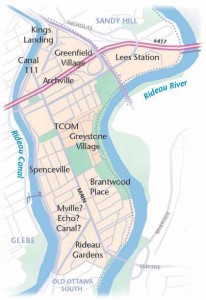JOHN DANCE
After about 150 years of settlement, the development of Old Ottawa East (OOE) has resulted in about 10 linked villages, each with distinct characteristics and relatively clear boundaries. Few other communities in Ottawa have such varied, defined and linked components. OOE’s evolution has been chunky, as particular areas such as Brantwood Place and Greystone Village have been built, and residential areas have replaced farming, industrial and institutional uses.
“A particular aspect of Old Ottawa East is its
aggregation of smaller communities – a
village of villages…Each of the parts…have
their unique histories, architectural and
design styles, socio-economic profiles, landscapes.”
- Anthony Leaning
OOE resident, architect
This article refers to the disaggregated components of OOE as “villages” simply because the definitions of “community” and “neighbourhood” are somewhat overlapping, and the term “village” is already in lasting use within OOE. Also, as architect Anthony Leaning, an OOE resident, commented, “A particular aspect of Old Ottawa East is its aggregation of smaller communities – a village of villages, sort of. Each of the parts, Spenceville, Archville, Brantwood, and now Greystone, have their unique histories, architectural and design styles, socio-economic profiles and landscapes.” The first village was the “subdivision” known as Spenceville, founded in 1868 and named after Rev. Alexander Spence of St. Andrew’s Presbyterian Church, Ottawa’s first Protestant church, which owned the land. Spenceville extended from Hazel Street to Clegg Street along the Rideau Canal. The second neighbourhood was Archville founded in 1873 and named after Archibald Stewart, son of the owners of the land. This village extended from the Rideau Canal to Harvey Street.
In 1888, these first two villages became the “police village” of Ottawa East and, by being so incorporated, avoided – for nine years – annexation by the City of Ottawa. Brantwood Place became the next distinct village with Robert Sibbitt launching the development in 1911 – but it was a slow process to build this “exclusive” residential area, east of Main Street and south of the institutional properties.
Meanwhile several substantial homes were built in the area south of Clegg Street and west of Main Street. Gradually, the land south of Clegg Street was built up, some parts spottily, but other parts intensively. In the 1940s, Merritt and McNaughton avenues were built up with repetitive styles and Mason Terrace, Mount Pleasant Avenue and Mutchmor Road were populated with Rupert McClelland designed houses featuring distinctive rounded front doors.

The ten “villages” of Old Ottawa East each have their own unique characteristics, styles and feel about them, as John Dance explains. Map Image by Steve Fick
In the 1950s and 60s the area south of Brantwood and further along the river on the west side of Main Street was developed like a modern subdivision, albeit with large and lovely lots. From a real estate point of view, this area was deemed Rideau Gardens, although the original Rideau Gardens – which provided much of Ottawa’s fresh produce – was strictly on the west side of Main. This reality did not, however, deter the city’s toponymists from creating Rideau Garden Drive (singular for reasons unknown) on the east side of Main.
Meanwhile, in the 1940s, the original Spenceville and Archville villages were filled in and extended to include Chestnut Street’s bakers’ houses of the Walker’s Bread factory. Over the next few decades, the various industries of Old Ottawa East, primarily located near the eastern section of Lees Avenue, shut down, thus freeing up land for residential and other uses, including the Eastern Ontario Institute of Technology, which became Algonquin College and is now the Lees campus of the University of Ottawa. Five large apartment towers were subsequently built on Lees Avenue.
The section of OOE north of the Queensway was also transformed in the late 1980s and beyond, with the new developments of Canal 111 (on the site of the demolished Morrison Lamothe Bakery), Greenfield Village, the Brownstones and Kings Landing. Meanwhile, vacant lots in the neighbourhood were filled with new multi-unit rows, and small houses were demolished to make way for larger or multiple dwellings.
Other major changes were the construction of large apartment buildings and condominiums along Main Street, the first being at the corner of Main and Lees Avenue in the 1970s, with the luxury condominiums – 10 Main and the Glassworks – north of the Queensway following decades later. These buildings, like Canal 111, are in some respects like mini-villages, with residents who have lived there for long periods and with condominium corporations providing governance and community.
The Old Ottawa East community design plan of 2011 paved the way for the newest villages: Domicile’s The Corners on Main (“TCOM”) and The Regional Group’s Greystone Village, the former on the site of the convent of the Sisters of the Sacred Heart and the latter occupying the Oblates lands. The Greystone name was devised for marketing purposes, but it does relate to the impressive grey stone Deschâtelets Residence at the heart of the new development and of the OOE community overall.
So what remains to be built? Both Greystone Village and TCOM are about half completed but the City wants much more development near the Lees Avenue LRT Station. Most of the available land near the Lees Station area is owned by the University of Ottawa, and the notion is that the university’s existing structures and facilities, including the sports field, will be replaced by towers even higher than the existing apartments just to the west.
The character of the various villages of OOE is diverse. Archville, for instance, has an intimate “everybody-knowseverybody” feel, similar to what you experience in Spenceville. In the villages south of Clegg Street, with larger homes on larger lots, there is an open and quieter feel, especially as you move into Rideau Gardens. And given the wide range of housing prices, including some of the highest in Ottawa along Echo Drive, there is considerable economic diversity from one village to another.
Most of the villages have enduring names but the one bounded by the Rideau Canal, Clegg Street, Main Street and Riverdale Avenue remains nameless. Some options are Mville (given the large number of streets beginning with the letter M), Echo or Canal. Founding families of historical note who pioneered the area could also lend their names to this as yet unnamed village: Brownsville, Slatterytown or Bower Village.






